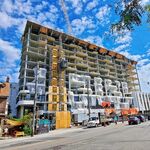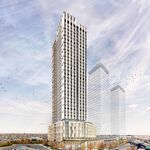Steve X
Senior Member
It's not like the VIVA have removed a single car of the road! The same awful headway still exist. It's only rapid transit in the fantasy world.5 years of constructionand traffic is still as bad as ever.
It's not like the VIVA have removed a single car of the road! The same awful headway still exist. It's only rapid transit in the fantasy world.5 years of constructionand traffic is still as bad as ever.
I'm not sure that I've seen or understand how traffic signal priority is going to work on the above ground section. Without full grade separation, isn't there a big risk that the above ground section could bottleneck the whole line?
The suburban politicians will do their best to get the worst possible transit priority, and keep the single-occupant motor vehicle as "king or queen" of the road.
As a point of comparison:No, it was always planned for prep work. Utilities relocation will begin sometime soon (if it hasn't happened yet). That would take them up to a year. They'll widen the roadway in 3 phases, medium, north and south side (don't remember which is first). That's 2-3 months per phase.
If they started prep work in 2020, it won't finish within a year. The actually track and overhead work won't happen till closer to 2020. Even the VIVA rapidways took much longer than a year.
Is there a lot of utilities that they need to relocate shirly most of it would be closer to the curb lanes then in the middle of the road. I guess I could see them laing Hydro lines down the middle of the street to feed up through the ploes so they don't have to string lines across the street to supply power to them.
There are places where hydro lines on regular wooden poles come down a street, dive into the ground at the sidewalk, and then pop up back out of the sidewalk on the other side of the LRT, where the wooden poles continue like nothing happened. It's amusing.In KW they buried every hydro line that crosses the tracks, so high voltage AC couldn't fall onto DC transit power and blow the works if a car ever hit a pole.
It's not like the VIVA have removed a single car of the road! The same awful headway still exist. It's only rapid transit in the fantasy world.
I'm actually referring to VIVAnext (the bus lanes). Hence the 5 year construction that I was quoting. I agree with a limited stop service does help carry people.That two mainVIVA routes, Blue and Purple, are very well used.
The population of the region grew a lot in the past five years. The traffic would be worse if VIVA did not exist.
It might just be a net equivalence. The population increases, then the bus usage increases, but so does car usage. Therefore, there's no visible change in the use of cars, but the bus usage definitely increased. The Crosstown will attract more riders, but it may not be enough to counteract population increase.Have the headways increased in the last 5 years? I doesn't seem like the bus lanes have removed more people from their cars.
I'm actually referring to VIVAnext (the bus lanes). Hence the 5 year construction that I was quoting. I agree with a limited stop service does help carry people.
How many times have I seen nobody on those stations along Highway 7. Well used? A bus every 15 minutes is not considered well used. With the VIVA Pink, it's around 7-8 minutes combined. It's still not consider well used. VIVA Blue is better through. One to three people using each station is not considered well used in the BRT world. Only in terms of YRT. I know it's not the TTC.
Have the headways increased in the last 5 years? I doesn't seem like the bus lanes have removed more people from their cars.
The at-grade Eglinton East section of the Crosstown is something Toronto will regret for a very long time. The only reason LRT was suggested was due to Miller and his "great city building" propaganda like somehow the Golden Mile was a Yorkville in the making. It should be grade separated {elevated} across the entire route.
This line will only be able to have frequencies of every 4 minutes each way max as opposed to a grade separated line that could run every 90 seconds and be cheaper to run due to automation. When considering the huge cost of this project, LRT was the slowest, most unreliable, lowest capacity, lowest frequency, and most expensive system to run they could have thought of.
Anything is that TC {and very much Eglinton} was based on Miller's population estimate of Toronto reaching 4 million by 2030 but it set to cross that marker with 1 to 2 years and will probably be closer to 3.5 million by 2030. That's an extra 500,000 people not being taken into consideration in this project. The Canada Line with it's McStations will still have higher capacity than the Crosstown but be much faster, more reliable, safer, and less intrusive than this mega project.




